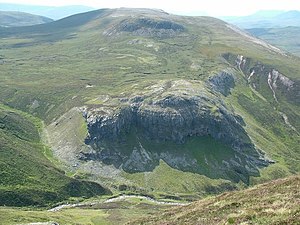Beinn an Fhuarain: Difference between revisions
Created page with "{{Infobox hill |name=Beinn an Fhuarain |county=Sutherland |range=Assynt |picture=Western Slopes of Beinn an Fhuarain - geograph.org.uk - 988689.jpg |picture caption=On Beinn a..." |
mNo edit summary |
||
| Line 3: | Line 3: | ||
|county=Sutherland | |county=Sutherland | ||
|range=Assynt | |range=Assynt | ||
|picture= | |picture=Bone Caves Crag from Beinn nan Cnaimhseag - geograph.org.uk - 1022792.jpg | ||
|picture caption= | |picture caption=Beinn an Fhuarain and the Creag nan Uamh | ||
|os grid ref=NC260158 | |os grid ref=NC260158 | ||
|latitude= 58.097428 | |latitude= 58.097428 | ||
| Line 17: | Line 17: | ||
[[File:Summit cairn, Beinn an Fhuarain - geograph.org.uk - 1252786.jpg|right|thumb|200px|Summit of Beinn an Fhuarain]] | [[File:Summit cairn, Beinn an Fhuarain - geograph.org.uk - 1252786.jpg|right|thumb|200px|Summit of Beinn an Fhuarain]] | ||
[[File:Western Slopes of Beinn an Fhuarain - geograph.org.uk - 988689.jpg|right|thumb|200px|On Beinn an Fhuarain]] | |||
Latest revision as of 22:21, 30 September 2016
| Beinn an Fhuarain | |||
| Sutherland | |||
|---|---|---|---|
 Beinn an Fhuarain and the Creag nan Uamh | |||
| Range: | Assynt | ||
| Summit: | 1,647 feet NC260158 58°5’51"N, 4°57’10"W | ||
Beinn an Fhuarain is a limestone hill in the Assynt district of Sutherland. It rises to 1,647 feet to the east of the A837 in a distinct top: immediately to the east though begin the crags and peaks which rise up to the county's highest mountains, Conival and finally Ben More Assynt, whose neighbouring summits stand about four miles to the northeast of Beinn an Fhuarain.
The nearest village is Inchnadamph on the southern tip of Loch Assynt, four miles to the north.
The hill is separated from Beinn nan Cnaimhseag (1,870 feet) by the valley of a stream named Allt nan Uamh, which means "Stream of the Caves". Above this valley is a crag named Creag nan Uamh ("Crag of the Caves") and in the face of the cliff are a set of remarkable caves, the Bone Caves of Inchnadamph in which have been found the bones of creatures which lived in these parts during the Ice Age, including the only polar bear skeleton yet found in the British Isles.

